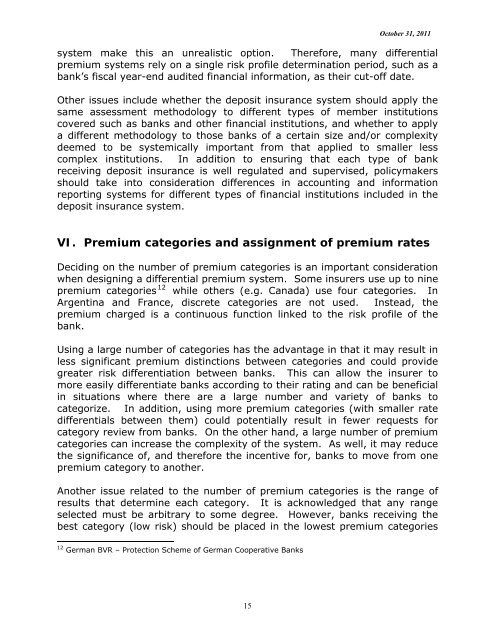General Guidance for Developing Differential Premium Systems
General Guidance for Developing Differential Premium Systems
General Guidance for Developing Differential Premium Systems
Create successful ePaper yourself
Turn your PDF publications into a flip-book with our unique Google optimized e-Paper software.
October 31, 2011<br />
system make this an unrealistic option. There<strong>for</strong>e, many differential<br />
premium systems rely on a single risk profile determination period, such as a<br />
bank’s fiscal year-end audited financial in<strong>for</strong>mation, as their cut-off date.<br />
Other issues include whether the deposit insurance system should apply the<br />
same assessment methodology to different types of member institutions<br />
covered such as banks and other financial institutions, and whether to apply<br />
a different methodology to those banks of a certain size and/or complexity<br />
deemed to be systemically important from that applied to smaller less<br />
complex institutions. In addition to ensuring that each type of bank<br />
receiving deposit insurance is well regulated and supervised, policymakers<br />
should take into consideration differences in accounting and in<strong>for</strong>mation<br />
reporting systems <strong>for</strong> different types of financial institutions included in the<br />
deposit insurance system.<br />
VI. <strong>Premium</strong> categories and assignment of premium rates<br />
Deciding on the number of premium categories is an important consideration<br />
when designing a differential premium system. Some insurers use up to nine<br />
premium categories 12 while others (e.g. Canada) use four categories. In<br />
Argentina and France, discrete categories are not used. Instead, the<br />
premium charged is a continuous function linked to the risk profile of the<br />
bank.<br />
Using a large number of categories has the advantage in that it may result in<br />
less significant premium distinctions between categories and could provide<br />
greater risk differentiation between banks. This can allow the insurer to<br />
more easily differentiate banks according to their rating and can be beneficial<br />
in situations where there are a large number and variety of banks to<br />
categorize. In addition, using more premium categories (with smaller rate<br />
differentials between them) could potentially result in fewer requests <strong>for</strong><br />
category review from banks. On the other hand, a large number of premium<br />
categories can increase the complexity of the system. As well, it may reduce<br />
the significance of, and there<strong>for</strong>e the incentive <strong>for</strong>, banks to move from one<br />
premium category to another.<br />
Another issue related to the number of premium categories is the range of<br />
results that determine each category. It is acknowledged that any range<br />
selected must be arbitrary to some degree. However, banks receiving the<br />
best category (low risk) should be placed in the lowest premium categories<br />
12 German BVR – Protection Scheme of German Cooperative Banks<br />
15

















